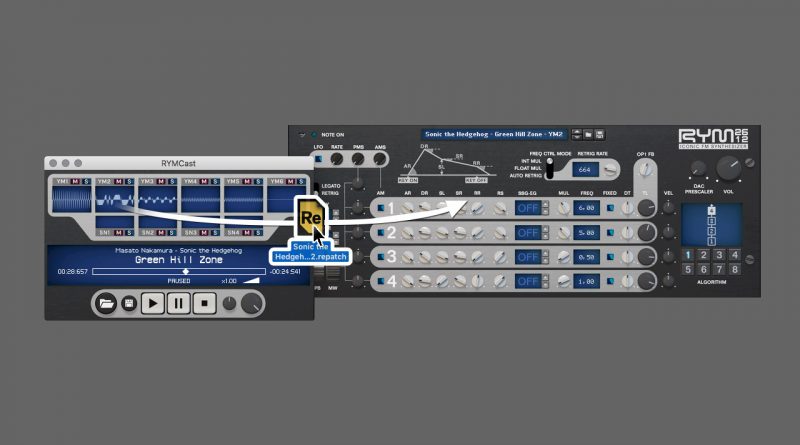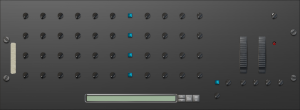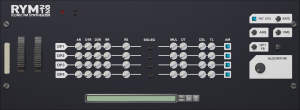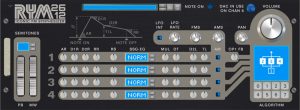Meet RYMCast! And the team behind it and the RYM2612
UPDATE February 17, 2017:
RYMCast has left the beta stage and version 1.0.5 is released alongside this wonderful new video!
Head on over and check out RYMCast!
An interview with Mathieu Demange and William Lamy
In October, Mathieu Demange released the RYM2612 Iconic FM Synthesizer Rack Extension, an emulation of the Yamaha YM2612 soundchip, best known for being the vibrant voice of the Sega Genesis/Mega Drive videogame console. Recently, he teased us with RYMCast (in public beta at the time of this interview), a VGM player for Sega Genesis/Mega Drive videogame music files capable of exporting patches to the RYM2612. The ReasonTalk team had the opportunity to discuss this exciting news and more with Mathieu and his teammate in design, William Lamy (Willbe).
ReasonTalk (Joey): Hi, Mathieu! First, can you tell us a little bit about yourself? How did you become a developer?
Mathieu Demange: I’m a 31-year-old French musician (pianist and percussionist), programmer, teacher and electronic hobbyist. I was given my first computer (an Atari ST) when I was five and grew up with all the fascination for music, computing and every electronic system capable of making a beep.
It’s hard to tell how I got into being a developer because that’s almost the first thing I was introduced to by my father when he offered me his 1040STF. He told me that a computer’s CPU is a rather non-intelligent piece of electronic, but that it can handle millions of operations per second! Tell that to a kid who barely knows about addition and you’ll see stars in his eyes, ahah! Electronic just started to be a lesser form of black magic to me, but when it was, programming was my only option to use that magic. It’s the way I like most to put my hands literally _into_ things.
RT (Joey): Wow! You got a pretty early start! And when did you start using Reason?
MD: I met Reason 2 when I was in college. Reason was one of the mind blowing experiences I had with computer and music. I was still listening to tracker modules when I first heard this (I actually recorded the demo songs onto MiniDisc to listen to them when going to school). I instantly was fascinated by the virtual rack. There were a dozen real rack instruments at our place when I was a child and my father showed me how to play the built-in demos on those synths, so I immediately felt at home with the Reason rack.
RT (Joey): I had a similar experience when I first started using Reason 1. And I too recorded onto MiniDisc! Glad you found a home with Reason. So what inspired you to make the RYM2612? Are there any particular video game titles/songs that made you a fan of Sega Genesis/Mega Drive music? What are your favorites?
“Before having my own Genesis, I was a terrible co-player because I was mostly interested in listening to the background music from Streets of Rage!”
MD: Love made me do it… and frustration! I fell in love with the sound of the Genesis even though I didn’t own one at first. I even borrowed a friend’s Model 1 to record all the Sonic soundtracks onto tapes. I didn’t care about console wars, and I knew the SNES had interesting audio capabilities too. But to me, the sound of the Genesis always had something special, even though the timbre didn’t feel as realistic as with PCM capable systems (like the SNES). I felt it had more synthesis potential. And nice bassy sounds!
Maybe it sounded familiar because I played a lot on our DX7 back then, but I admit I didn’t even know what FM synthesis meant at that time. It was a coup de foudre, that’s it! Before having my own Genesis, I was a terrible co-player because I was mostly interested in listening to the background music from Streets of Rage! My favorite game soundtracks are Streets of Rage (1 & 2), Sonic (1 & 2), Shinobi III, Street Fighter 2: Champion Edition, to name a few.
RT (ScuzzyEye): A lighthearted question: Any chance that you sharing the initials MD with the Mega Drive had anything to do with your interest in the console?
MD: That’s pure coincidence with my own initials, but I deliberately like it 😉
RT (Joey): As the description of the RYM2612 states, “Not many people were aware of this, but unlike other videogame consoles, the Sega Genesis/Mega Drive had a complete FM synth onboard” I was one of those people who learned something new! How did you go about emulating the YM2612?
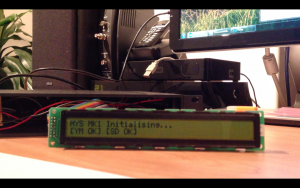
MD: It kinda began when I heard (sometimes barely) noticeable differences between a real YM2612 and emulation. I spent years learning everything I could about this chip, until I found a few dozen never used real discrete chips. I made some hardware testing tools to further explore the chip’s behavior and sound (video).
At first, I wanted to make a real hardware YM2612-based MIDI synthesizer (there’s one living prototype in my closet), but I finally ended up writing my own emulation core and asked William Lamy to be part of the design process of the RYM2612.
RT (Joey): Welcome, William! Can you tell us a little bit about yourself and the design?
William Lamy: To introduce myself the simplest way possible : I’m the guy who makes graphics for Mathieu’s machines. And since we are both musicians, we discuss a lot about user interface, to make it as easy and able as possible. At first we wanted to take elements from the Sega Genesis : black plastic, round shapes and all. But we figured it gave a cheap perception regarding the sound quality Mathieu wanted to achieve. We wanted to make it look more “pro.” A real serious synth, and as Propellerhead inspired it with the SDK, like a real machine you could actually build.
RT (ScuzzyEye): Cool. That’s what I was wondering; why you didn’t just make it look like a Genesis.
WL: Well, we wanted to give a lot of access to all the chip settings, for all 4 operators. This alone throws a lot of rotary knobs in the canvas.
RT (Joey): It’s always interesting to see early design iterations. Do you have any you can share?
MD: Oh my! I just found some antiques…
This is really the first GUI iteration. “Know this synth? Prove it!” More seriously, I was only working on DSP code at that moment. But the total amount of knobs was a problem then.
And this was a first attempt at grouping things together and finding some sort of workflow for each operator’s controls. Entered William Lamy at this point…
And here is an early design by William.
RT (Joey): Thanks for sharing those! The intro video for RYM2612 is incredible! William, was that your work as well?
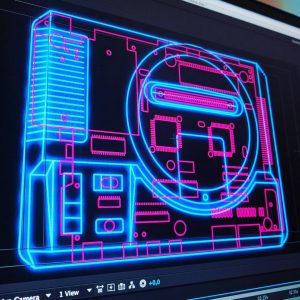
WL: Yes, thanks. I work as a motion designer in a web agency. It helps a lot these days.
RT (Olivier): Very cool indeed. What did you make that with if I may ask?
WL: Thanks! It’s made with the Adobe creative suite, mainly After Effects and Illustrator.
MD: William, what was your first Reason version, again?
WL: V1, love at first sight 🙂 And nearly all my music since 2002 is composed with Reason. Here’s a very old page that gives a quick resume of my design works with Reason. I was very active in the demoscene, a community of coders, 2D/3D designers, musicians, that was born in the 80’s with 8bit home machines, and that is still active today on PC and various platforms.
RT (Joey): Were you a Genesis kid as well?
WL: I was in team Sega. I had a SMS, and was lucky enough to borrow a Genesis from a friend to finish Sonic 1. I didn’t like the NES so much…
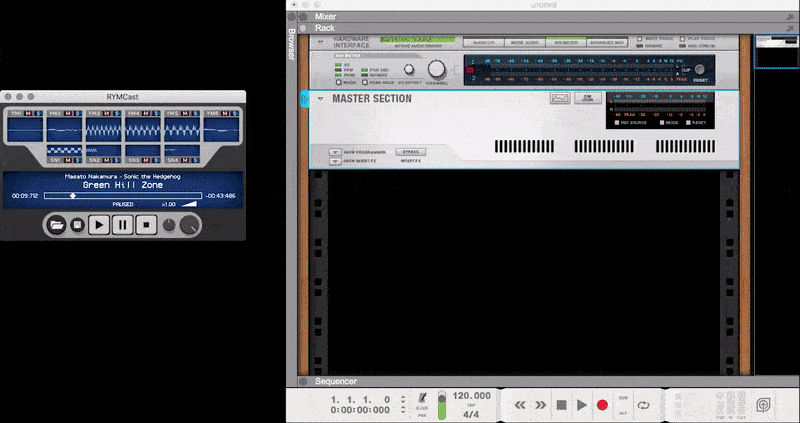
RT (Joey): Mathieu, recently you posted a teaser of RYMCast and it looks awesome and intriguing! Can you tell us a little bit about how that came about and how it works? Will it load any VGM file and translate parts to repatch files for RYM2612?
MD: That’s one of its features, yes. You can actually pause the VGM stream during playback and the synth engines will keep running (and sounding) in their “frozen” state. RYMCast can then read out the register values from each channel and convert them to .repatch and .dmp files. More on RYMCast here.
RT (Kenni): For the readers who are probably new to this world, is there a resource where you can obtain Genesis music files?
MD: project2612.org. And I’d also like to say hi to the great 16-bit Audiophile Project, which was a wonderful source of inspiration to create RYMCast. We even used their superb recordings as reference material to fine tune our player.
RT (tiker01): Have you considered porting the RE to other platforms e.g. iOS?
MD: Yes. We first want to release a VST/AU/RTAS version then an iOS version afterward, because this will need some UX re-thinking. I just hope it won’t take too long before it’s reality 😉 and we also have other projects in mind (our next RE notably).
RT (ScuzzyEye): Any hint as to what the next RE will be?
MD: Let’s say I’ve not been wasting my time, spending months reverse engineering one mythic sampler for its appreciated “warmth” and lo-fi that I’ll try to put into an effect.
RT (Joey): Looking forward to seeing what it is! Well thank you both for joining us and sharing some very interesting information about yourselves and behind the scenes!
MD: It’s a real pleasure, thank you all!
WL: Thank you!
RYMCast and RYM2612 information
Head on over and check out RYMCast!
RYMCast Features:
- Cycle-accurate YM2612 emulation and output modeling, including Ladder Effect and filtering (uses the same audio engine as the RYM2612)
- Individual scopes for each channels
- Per channel mute and solo
- VGM stream speed adjust
- Sequencer-like pause function
- Audio export to WAV, AIFF & FLAC formats
- Stereo or multi track audio export
- Instrument patch extractor (supports RYM2612’s .repatch and Deflemask‘s .dmp formats)
Resource for VGM files: project2612.org
Try or Buy RYM2612 from the Propellerhead Shop and start using it alongside RYMCast to easily get your favorite Sega Genesis/Mega Drive sounds into the Reason rack!

